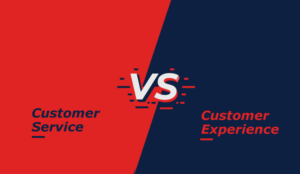Hervé Leroux of Odigo discusses the difference between customer service and customer experience and how both make or break a business.
Customer service vs. customer experience – is there a difference?
On the surface they seem like interchangeable terms to describe the same idea, namely, meeting customers’ needs in a pleasant and efficient manner.
However, closer inspection reveals that while both play a vital role in a brand’s customer experience strategy, there are significant differences between them, which successful organisations need to understand if they want to establish, and continually develop, a loyal customer base.
Even before the cataclysmic economic impact of the COVID-19 pandemic, the World Bank had predicted sluggish growth for 2020.
Now, as economies contract and businesses fight for survival, corporate leadership knows getting customer service and customer experience right has never been more vital.
Customer Service – The Traditional Way of Connecting and Meeting Needs
At the most basic level, customer service, in the words of Salesforce, is: “The support you offer customers both before and after they buy and use your products or services.”
Whereas Forbes regards customer service as: “The advice or assistance a company provides its customers, with the goal of increasing customer satisfaction, usually achieved through answering questions.”
While the concept of customer service is quite simple – since it is a necessary function of any business – the consequences can be profound.
According to Statista research, 41% of British consumers choose great customer service as the biggest driver of customer loyalty.
Maintaining a loyal base pays dividends, as investing in new customers is between 5 and 25 times more costly than keeping existing customers, according to invesp.
As corporate boards try to strike a balance between trimming costs and investing in growth, customer service remains the most effective means of driving profits and generating revenue.
HubSpot research indicates that 93% of customers are likely to make repeat purchases with companies that provide excellent customer service.
Essentially, the best advertisements and promotional material is simply rewarding customer service.
Customer Experience – The Sum of All Interactions
Customer experience is a modern reboot of an old principle, one that builds on the customer service axioms and adds more expectations, reflecting the changing lifestyles, various channels, and new technologies that shape contemporary customers’ habits, needs, and goals.
In the words of Forrester, a leading market research company, customer experience describes: “How customers perceive their interactions with a company.”
Zendesk explains: “Customer experience is everything related to a company or business that affects a customer’s perception and feelings about it.”
Moreover, customer experiences take into account three perspectives: usefulness, practicality, and enjoyability.
If something is useful, it delivers value, if it is practical, it is easy to use, and if it is enjoyable, it is emotionally engaging so that customers will want to continue using it.
Corporate management understands that technological developments have transformed all aspects of business, and customer experience is no exception.
Gartner, the foremost advisory company, believes that technology is a critical component of customer experience initiatives.
Gartner’s research identifies the top emerging technologies impacting customer experience projects as:
- Artificial intelligence (AI),
- Virtual customer assistants and chatbots,
- Omnichannel customer engagement,
- Real-time event-driven application architecture,
- Internet of things (IoT).
Delivering memorable customer experience can have an instant financial effect, as 78% of customers have backed out of a purchase due to poor customer experience, explains Glance, while noting it takes 12 positive customer experiences to make up for one negative experience.
The domino effect of a bad experience should not be underestimated, as Salesforce Research shows that 62% of customers share their bad experience with others, meaning damage to a brand’s reputation could be irreparable.
Customer Service vs. Customer Experience: Designing Effective Strategies
Both customer service and customer experience endeavour to meet customer demands and exceed expectations, while forming meaningful relationships that inspire loyalty and encourage word of mouth reference.
However, a major difference between them is that while customer service is reactive, deployed when an individual customer is not satisfied, customer experience is proactive and aims to reach every customer.
The evaluation of customer service and customer experience is also done differently.
While customer service is measured through the customer satisfaction score (CSAT), which rates how satisfied customers are with the interaction, customer experience is measured by net promoter score (NPS), which tracks how likely a customer will pass on a recommendation. Though different, obviously these objectives are linked.
Therefore, customer service vs. customer experience is not the issue. In actuality, customer service is simply one piece of the greater customer experience puzzle.
So, by investing and improving customer service, board members know their organisation automatically enhances customer experience.
Analysing data and understanding which channels customers prefer to solve certain situations is vital.
Intelligent routing, that is, connecting customers to the agent with the skillset to help, facilitates swift and smooth resolutions.
Rising customer expectations and demands for fast, convenient, and personalised support, combined with the need to manage interactions over various channels, mean that organisations face challenges in accomplishing outstanding customer service and rewarding customer experience.
By turning to cloud technology and implementing Odigo’s channel-less solution, organisations can optimise efficiency and streamline the communication process through linking all interactions (phone, email, social messaging) into one seamless journey.
A 360-degree customer view, intuitive console, and AI-powered bot support all deliver rewarding conditions for agents, who as brand ambassadors are ultimately the ones responsible for forming meaningful customer relationships through quality customer service and unrivalled customer experience.
Author: Guest Author
Published On: 4th Sep 2020 - Last modified: 8th Sep 2020
Read more about - Guest Blogs, Odigo














